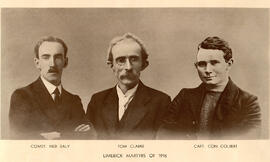The Daly Papers provide a unique insight into the birth of the Irish republic and the country’s search for an identity in the first decades of its existence. At the core of the collection is material relating to John Daly, a prominent Fenian and a source of inspiration to the generation that followed, as attested by the quantity of correspondence from numerous prominent republicans of the time. Of particular note is Daly’s correspondence with Thomas Clarke (P2/2/1/11/1, 3, 5 and 6; P2/2/1/18/9-21, 23-27 and 29-30). Other items of note include Seán Mac Diarmada’s account of his part in the Howth gun-running operation (P2/2/1/31/8); Edward (Ned) Daly’s last letter to his mother on the eve of the Easter Rising (P2/2/1/17/2); and Kathleen Clarke’s letters to her sisters during her imprisonment in 1918-19 (P2/2/1/10/4-10). The latter also illustrate the role of women in the formation of the Irish republic, as do several other items of correspondence in the collection. Madge Daly’s draft memoirs (P2/2/2/2/1-5) provide a first-hand account of the events leading up to and immediately following the Easter Rising. Her account of a visit to Kilmainham Jail to see her brother Edward (Ned) Daly prior to his execution (P2/2/2/3/1) offers a unique insight into the hardship suffered by the families of the leaders of the Easter Rising, and added poignancy is provided by personal effects in Ned’s possession which were returned to the family after his death (P2/4/1/3). The large volume of photographs contained in Series 6 provides further insights into the main players of this most turbulent of times.
Material relating to the Dore branch of the Daly family opens a window into the young nation’s first steps as an independent state. Of particular interest are Edward Dore’s military medals (P2/4/3/1-4) and his determination to commemorate the Easter Rising in Limerick City which resulted in the erection of a memorial on Sarsfield Bridge in 1956 (P2/2/1/60/6/2, P2/3/1/3/1/1-4, P2/5/1/41 and P2/6/8/5-9); and his son Éamonn de hÓir’s impassioned campaign for the promotion of the Irish language (P2/3/2/3/3/1-14) and his extensive contribution to the study of Irish place names (P2/3/2/3/2/1-20). Also of note is de hÓir’s substantial research into the life of John Daly (P2/3/2/3/5/1-3 and P2/5/1/61-65) with a view to writing his biography, the publication of which was prevented by de hÓir’s untimely death.
The collection of letters and artefacts in the possession of the Daly family was originally considerably more substantial but the burning of their home in 1921 by the British Army destroyed much valuable material (see P2/2/1/19/3, P2/2/1/60/3/3, P2/2/1/62/5, P2/4/1/7 and P2/5/1/40). Records relating to the Daly family’s bakery in Limerick City are superficial, comprising mainly account books from Edward Dore’s time as manager. The fate of the papers relating to this business is unknown.
Daly Family of Limerick City